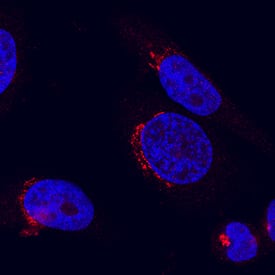Human beta-1,4-Galactosyltransferase 1/B4GalT1 Antibody
R&D Systems, part of Bio-Techne | Catalog # MAB36091

Key Product Details
Species Reactivity
Applications
Label
Antibody Source
Product Specifications
Immunogen
Ala44-Ser398
Accession # P15291
Specificity
Clonality
Host
Isotype
Scientific Data Images for Human beta-1,4-Galactosyltransferase 1/B4GalT1 Antibody
beta-1,4‑Galactosyltransferase 1/B4GalT1 in HeLa Human Cell Line.
beta-1,4-Galactosyltransferase 1/B4GalT1 was detected in immersion fixed HeLa human cervical epithelial carcinoma cell line using Mouse Anti-Human beta-1,4-Galactosyltransferase 1/B4GalT1 Monoclonal Antibody (Catalog # MAB36091) at 8 µg/mL for 3 hours at room temperature. Cells were stained using the NorthernLights™ 557-conjugated Anti-Mouse IgG Secondary Antibody (red; Catalog # NL007) and counterstained with DAPI (blue). Specific staining was localized to cytoplasm. View our protocol for Fluorescent ICC Staining of Cells on Coverslips.Applications for Human beta-1,4-Galactosyltransferase 1/B4GalT1 Antibody
Immunocytochemistry
Sample: Immersion fixed HeLa human cervical epithelial carcinoma cell line
Formulation, Preparation, and Storage
Purification
Reconstitution
Formulation
Shipping
Stability & Storage
- 12 months from date of receipt, -20 to -70 °C as supplied.
- 1 month, 2 to 8 °C under sterile conditions after reconstitution.
- 6 months, -20 to -70 °C under sterile conditions after reconstitution.
Background: beta-1,4-Galactosyltransferase 1/B4GalT1
beta4GalT1 is one of seven beta1,4 galactosyltransferases that transfer galactose in a beta1,4 linkage to acceptor sugars including GlcNAc, and Glc, and Xyl. By sequence similarity, the beta4GalTs form four groups: beta4GalT1 and beta4GalT2, beta4GalT3 and beta4GalT4, beta4GalT5 and beta4GalT6, and beta4GalT7 (1). beta4GalT1 is unique among the seven enzymes because it can be expressed either as membrane associated form or secreted form (2). The secreted form is restricted to lactating mammary tissues where the enzyme forms a heterodimer with alpha-lactalbumin to catalyze the synthesis of lactose (3). The membrane form can reside either in the Golgi apparatus, where it adds galactose to N-acetylglucosamine residues, or on cell surface, where it functions as a recognition molecule during a variety of cell to cell and cell to matrix interactions, by binding to specific oligosaccharide ligands on opposing cells or in the extracellular matrix (4). The two enzymatic forms result from alternate transcription initiation sites and post-translational processing (5). Defects in beta4GalT1 are the cause of congenital disorder of glycosylation type 2D (CDG2D) (6). The amino acid sequence of human B4GALT1 is 88%, 87% and 71% identical to that of rat, mouse/canine and chicken.
References
- Amado, M. et al. (1999) Biochim. Biophys. Acta. 1473:35.
- Yamaguchi, N and Fukuda, M.N. (1995) J. Biol. Chem. 270:12170.
- Appert, H.E. et al. (1986) Biochem. Biophys. Res. Commun. 138:224.
- Lopez, L.C. et al. (1991) J. Biol. Chem. 266:15984.
- Mengle-Gaw, L. et al. (1991) Biochem. Biophys. Res. Commun. 176:1269.
- Hansske, B. et al. (2002) J. Clin. Invest. 109:725.
Long Name
Alternate Names
Gene Symbol
UniProt
Additional beta-1,4-Galactosyltransferase 1/B4GalT1 Products
Product Documents for Human beta-1,4-Galactosyltransferase 1/B4GalT1 Antibody
Product Specific Notices for Human beta-1,4-Galactosyltransferase 1/B4GalT1 Antibody
For research use only
